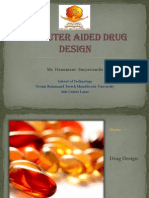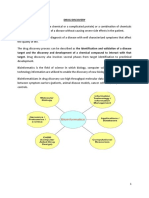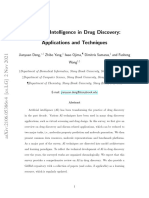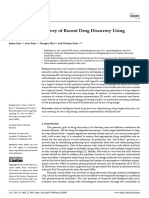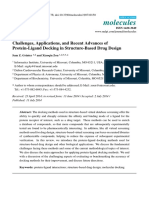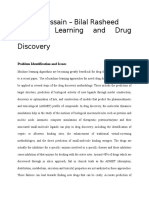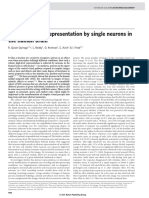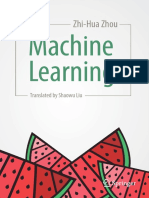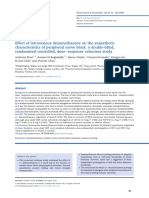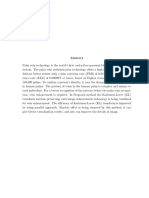Professional Documents
Culture Documents
Deep Action An Approach On The Basis of Deep Learning For The Prediction of Novel Drug-Target Interactions
0 ratings0% found this document useful (0 votes)
29 views6 pagesIn the processes of drug development and
discovery, Drug-target interactions (DTIs) take part a
vital position.
Original Title
Deep Action an Approach on the Basis of Deep Learning for the Prediction of Novel Drug-Target Interactions
Copyright
© © All Rights Reserved
Available Formats
PDF, TXT or read online from Scribd
Share this document
Did you find this document useful?
Is this content inappropriate?
Report this DocumentIn the processes of drug development and
discovery, Drug-target interactions (DTIs) take part a
vital position.
Copyright:
© All Rights Reserved
Available Formats
Download as PDF, TXT or read online from Scribd
0 ratings0% found this document useful (0 votes)
29 views6 pagesDeep Action An Approach On The Basis of Deep Learning For The Prediction of Novel Drug-Target Interactions
In the processes of drug development and
discovery, Drug-target interactions (DTIs) take part a
vital position.
Copyright:
© All Rights Reserved
Available Formats
Download as PDF, TXT or read online from Scribd
You are on page 1of 6
Volume 7, Issue 7, July – 2022 International Journal of Innovative Science and Research Technology
ISSN No:-2456-2165
Deep Action: An approach on the basis of Deep
Learning for the Prediction of Novel
Drug-Target Interactions
Hilma K K., Karthika Krishnan, Lima P Subran Prof. Neetha Joseph
Department of Computer Science and Engineering Faculty in charge, Department of Computer Science
Mar Athanasius College of Engineering and Engineering Mar Athanasius College of
Ernakulam, India Engineering Ernakulam, India
Abstract:- In the processes of drug development and
discovery, Drug-target interactions (DTIs) take part a I. INTRODUCTION
vital position. DTI prediction through laboratory
experiments consumes a lot of time. Also they were costly The DTI determination is a vast area of research which
and tiring. Although computational approaches can perform a crucial position in instigating advanced drugs for prior
recognize new interactions between drug-target pairs and targets and for identifying advanced protein target for studied
speed up the drug conversion procedures, some problems drugs. Number of potential untraced interactions were large and
many of the drugs identified were refused due to its side effects
like large scope of data and imbalanced class have been
or high toxicity. Conventional methods of laboratory
encountered in the course of the prediction procedures,
and the number of unknown interactions were huge. experimentation were expensive and laborious. Computational
Therefore, an approach on the grounds of deep learning approaches were developed to detect new DTIs. The public
(deepACTION) is put forward to predict possible or databases such as KEGG, DrugBank, etc,. which were developed
unrevealed DTIs. Here, each drug chemical structure and based on verified interaction information, reserve and render
protein sequence is transformed according to structural knowledge on the grounds of laboratory experiments for
and sequence information using different descriptors to constructing a computational application for determining latest
correctly constitute their properties. In this method the DTIs and are applied as the gold standard dataset. To tackle
majority and minority instances in the dataset are limitations of previous models, a Convolutional Neural Network
balanced using the SMOTE technique. For accurate DTI related model, deep ACTION is proposed to intoduce budding
DTIs with the help of chemical structure and sequence
prediction a convolutional neural network (CNN)
algorithm is trained with balanced and reduced features. information of drugs and proteins respectively. The pairs of drug-
For comparing the performance of the DeepACTION target and their corresponding chemical structures and protein
model with that of other methods AUC is regarded as the sequences were downloaded from the DrugBank database and
primary evaluation metric. An AUC curve of 0.933 is KEGG database.
achieved by Deep ACTION model for the experimental Firstly, the chemical structure of drug is converted to a
dataset acquired from the Drug Bank database. Based on topo-logical, constitutional, and geometrical form. Various
exper-imental results it is evident that the model is protein descriptors were utilized to describe sequence information
capable to predict a remarkable number of new DTI’s of a target sequence. Then the valid data is created by combin-ing
and it produce thorough knowledge that inspires the extracted drug-protein features. Here the interacting features
scientists to instigate advanced drugs. are indicated as positive pairs and non-interacting features as
Keywords:- Drug-target interaction, CNN, Data balancing. negative pairs. Then manage the imbalanced drug-target dataset
using a data balancing technique and finally the training model
for prediction of the interacting and non-interacting pairs were
constructed by utilizing CNN classifier. Subsequently, when
compared to other classifiers and methods, the suggested model
exhibits the highest performance.
Fig. 1: Deep Action model
IJISRT22JUL964 www.ijisrt.com 1544
Volume 7, Issue 7, July – 2022 International Journal of Innovative Science and Research Technology
ISSN No:-2456-2165
II. DRUG TARGET INTERACTION (DTI) B. Extraction of Drug-target features
In the dataset, drugs are represented in SMILES format
The binding of a drug to a target position which and targets in FASTA format. Simplified Molecular Input
concludes in an alteration in its behaviour or functionality is Line Entry System (SMILES) allows to describe the
referred to as Drug target interactions. A drug or medicine chemical structure of the drug in a way which can be utilized
primarily points to any chemical compound that could bring a by the system. The chemical structure of the drug which is a
physiological alterations in the human body when it is 3-dimensional representation will be difficult to be
ingested, injected or sucked up. Target aka biological target manipulated by the system. So in order to ease the procedure
can be any part of the living being to which the drugs get of determi-nation of drugs the 3D representation is converted
attached so as to introduce the physiological change. Entities to a 1D representation. This resulting format is the SMILES
like proteins or nucleic acids which are administered for any format. FASTA is an acronym for FAST-ALL. It is an
change are considered as targets. Nuclear receptors, ion alignment tool. FASTA format is used to describe the
channels, G-protein coupled receptors and enzymes are the nucleotide or amino acid sequences with single-letter codes.
most common biological targets. Specified drug and target IDs are used to gather the SMILES
and FASTA format from DrugBank and KEGG databases
DTI prediction takes part in an important position in the respectively. These IDs are available from KEGG database.
procedure of drug discovery. Drug discovery is focused in The extracted features are preprocessed.
the identification of unidentified compounds of the drugs for
different biological targets. Drug’s chemical compound get As the generated features may exist in varied length, all
attached to the molecules of target through bonds that are of them are trimmed to fixed length vectors and it is then fed
temporary. The chemical compounds of the drugs that are as an input to the chosen classifier. The features which are of
attached will then reciprocate with the biological target. This no or least importance in the prediction procedure will be
reaction may result in changes which can be positive or eliminated. In the end, an overall of 193 drugs and 1290
negative and accordingly draw out the target. In order to treat targets features are remained. It is then combined to form the
diseases, the drugs ward off certain catalyzed reactions drug-target pairs.
happening in the human body by inhibiting the functioning of
the target. It is attained by inhibiting the contact of drugs C. SMOTE For Balancing
with substrates, which is a kind of enzyme. In this proposed model, SMOTE technique which is an
over-sampling method is included to get hold of the
There are two ways for the occurrence of the DTIs: One imbalanced datasets and to create the training dataset of drug-
of the method is that, to impede the reaction the drugs which target pairs. For the sake of enhancing the prediction
are known as competitive inhibitors will affix themselves to capability of the classifier by balancing the minority class,
the active site of the target. Another method is that to avert SMOTE syntheti-cally give rise to positive samples of the
the substrate from recognizing target. It is done by allosteric experimental datasets. SMOTE procedure is as follows:
inhibitors which is a kind of drug which can affix to the Initially select a sample randomly and from the minority
target’s allosteric site. Thereby it alters target’s shape and class datasets detect the K-nearest neighbors for every
structure. Thus, reactions will not take place. The shutting off samples in minority class
of the reactions of the target can direct to the handling of The distance or dimension between the feature vector and
metabolic imbalances or can kill pathogens in order to cure its nearest neighbors are calculated
diseases. Then the difference is multiplied using a random number
DTI predictions has numerous applications. It can ease from [0 to 1].
the procedures of drug discovery, repositioning of drug and
This number is then added to the feature vector (sample)
prediction of side effects of drugs. Discovery of drugs can be
The process is continued until the minority and the majority
defined as the inquiry of new drugs which is capable of
classes have same number of samples and then stop the
interaction with a specified target.
process
III. BACKGROUND
D. Convolutional neural network
A Convolutional neural network (CNN or ConvNet) is a
A. Datasets
kind of artificial neural network(ANN) and is employed in
The dataset required for the experiment was freely
pattern recognition and image processing. It is particularly
available from DrugBank which is a Canadian online
designed to exercise on pixel datas. They are recurrently
database. It contains information related to the drugs and
utilized for various applications, such as analysis of voice,
targets. In the dataset, overall 12,674 interactions between
systems for recommendations, recognition and classification
drugs and targets are available. It comprises of 5877 drugs
of videos and images and processing of natural language.
and 3348 target proteins. Distinct interpretations of the
ConvNet can reduce the images into a form that is convenient
DrugBank dataset were utilized as standard datasets in earlier
to process, without eliminating features that are crucial for
researches.
making a good prediction. Generally, CNNs consist of an
input layer, output layer and multiple hidden layers (MHLs).
Multiple hidden layers in CNNs may include many
convolutional layers (CLs). To alleviate the problem of
model over fitting that may add noise to the HLs randomly, a
dropout layer is assigned. Drop out layer is a regularization
IJISRT22JUL964 www.ijisrt.com 1545
Volume 7, Issue 7, July – 2022 International Journal of Innovative Science and Research Technology
ISSN No:-2456-2165
strategy. The nodes which are indicated as ‘dropped out’ will A. Performance analysis
not either join in back propagation or assist in the forward By setting parameters train the model on the basis of
pass. A common activation function called RELU layer is train-ing data. Some of the metrics for analyzing the
included and is accordingly observed by extra convolution performance include Accuracy, Sensitivity, Specificity and
layers. MCC . The AUC metric is used to evaluate the performance
of deepACTION method. Then plot the ROC curve with TPR
In CNNs, main structure blocks are convolutional (sensitivity) in X-axis and FPR (1-specificity) in Y axiz by
layers. For training more significant features deeper CLs are adjusting with different thresholds.
applied. This is achieved by including sliding kernels on the
upper part of the earlier layers. Usually after each CL the B. Performance analogy with other classifiers
pooling operation is applied. Thus, PLs can reduce the A comparison with various classifiers on the Drug Bank
number of features provided and by local nonlinear functions dataset was performed to analyse the effectiveness and
can offer translation invariance . robust-ness of the deep ACTION model. Different classifier
models obtain different accuracy values on same set of data.
IV. EXPERIMENTAL RESULTS
The CNN classifier produced the highest AUC of
The suggested approach is entirely implemented with 0.9133 for the dataset. GBN classifier achieved the second-
Python (version 3.6) as the programming language. Also highest result, with the performance AUC value of 0.8930.
incorporates Pytorch and scikit-learn library. Spyder, a free The classifiers Random Forest and KNN have performance
and open source environment which is written in Python is AUC value of 0.885 and 0.882 respectively.
the em-ployed IDE. For the implementation on neural
networks, Keras and tensorflow are included. Various tests The CNN classifier have comparatively higher AUC
were performed to examine the accuracy of various values than the value obtained by the classifiers GBN,
classifiers and balancing and selection approaches used. At Random Forest and KNN. By comparing the AUC values, it
the end, the classifier will put forward a list of the unused is clear that the accuracy of CNN is 2.03%, 2.83%, and
potential interactions. 3.13% higher than the other classifiers used respectively.
Fig. 2: Performace Evaluation: Accuracy
Fig. 3: ROC Curve Before and After Balancing Using SMOTE
IJISRT22JUL964 www.ijisrt.com 1546
Volume 7, Issue 7, July – 2022 International Journal of Innovative Science and Research Technology
ISSN No:-2456-2165
V. FUTURE RESEARCH tation method that uses SMILES sequences of the interacting
ligands to describe proteins. So that both the input dataset can
Presently the project uses a SMILES format to represent be represented in the same format.
drugs and FASTA format to represent proteins. As a future
work, it is possible to utilize a ligand-based protein represen-
Fig. 4: ROC Curve of GBN
Fig. 5: ROC Curve of KNN
Fig. 6: ROC Curve of RandomForest
IJISRT22JUL964 www.ijisrt.com 1547
Volume 7, Issue 7, July – 2022 International Journal of Innovative Science and Research Technology
ISSN No:-2456-2165
Fig. 7: Performance comparison of different classifiers
Also, a drug-target dataset (networks) which is REFERENCES
heteroge-neous with auPR matrices for experiments can be
considered and a stand-alone web application can be [1.] S.M. Hasan Mahmuda, Wenyu Chena, Hosney Jahanb,
developed by pro-viding simple mechanisms and a user- Bo Daia, Salah Ud Dina, Anthony Mackitz Dzisoo,”
friendly interface for the model. In future, research can also DeepACTION: A deep learning-based method for
be extended to predict related directions such as drug-drug, predicting novel drug-target interactions”, October
drug side effects, and protein diseases. 6,2020..
[2.] ShanShan Hu, DeNan Xia, Benyue Su, Peng Chen ,
By integrating multiple heterogeneous data sources of Bing Wang , and Jinyan Li,”A Convolutional Neural
drugs and targets, a more efficient prediction model can be Network System to Discriminate Drug-Target
created. Interactions”, August 2021. .
[3.] Ping Xuan , Bingxu Chen, Tiangang Zhang , and Yan
VI. CONCLUSION Yang, ”Prediction of Drug–Target Interactions Based
on Network Representation Learning and Ensemble
The project developed a model based on deep learning Learning”, December 2021.
called deepACTION for the prediction of interactions [4.] ABDELRAHMAN I. SAAD , YASSER M. K. OMAR,
between drugs and targets . Interactions between drugs and AND FAHIMA
targets are determined using CNN algorithm. The drug-target [5.] MAGHR, ”Predicting Drug Interaction With Adenosine
structure is represented in numeical form by utilizing various Receptors Using Machine Learning and SMOTE
feature extraction techniques. Related works used different Techniques”, October 22, 2019.
methods to manage the imbalanced datasets. DeepAction [6.] SKonstantinos Pliakos , Celine Vens , and Grigorios
model include SMOTE to manipulate the majority (negative) Tsoumakas, ”Pre-dicting Drug-Target Interactions With
and minority (positive) instances in the dataset. SMOTE Multi-Label Classification and Label Partitioning”,
balance class distribution by randomly increasing minority August 2021.
class samples by replicating them. [7.] S. M. H. Mahmud, W. Chen, H. Jahan, Y. Liu, N. I.
Sujan and S. Ahmed, ”iDTi-CSsmoteB: Identification
Different classifiers such as CNN, GBN, Random of Drug–Target Interaction Based on Drug Chemical
Forest and KNN were applied. CNN returned higher Structure and Protein Sequence Using XGBoost With
accuracy of 91.33% compared to other classifiers. GBN Over-Sampling Technique SMOTE,” in IEEE Access,
classifier returns the second-highest accuracy of 89.30%. vol. 7, pp. 48699-48714, 2019, doi:
Random Forest and KNN produced accuracy of 88.5% and 10.1109/ACCESS.2019.2910277.
88.2% respectively. [8.] M. Campillos, M. Kuhn, A.C. Gavin, L.J. Jensen, P.
From the experimental results it is evident that the deep- Bork, Drug target identification using side-effect
Action method attains highest prediction performance and is similarity, Science 321 (2008) 263–266,
capable to predict novel drug-target pairs from the DrugBank https://doi.org/10.1126/ science.1158140, 80-.
dataset. The improved performance of proposed model may [9.] H. Yu, J. Chen, X. Xu, Y. Li, H. Zhao, Y. Fang, X. Li,
motivate scientists to utilize this method in prediction of new W. Zhou,
DTIs. [10.] Wang, Y. Wang, A systematic prediction of multiple
drug-target interactions from chemical, genomic, and
pharmacological data, PLoS One 7 (2012),
https://doi.org/10.1371/
[11.] S. Hu, C. Zhang, P. Chen, P. Gu, J. Zhang, B. Wang,
Predicting drug-target interactions from drug structure
and protein sequence using novel convolutional neural
networks, BMC Bioinf. 20 (2019) 1–12,
https://doi.org/10.1186/s12859- 019-3263-x.
IJISRT22JUL964 www.ijisrt.com 1548
Volume 7, Issue 7, July – 2022 International Journal of Innovative Science and Research Technology
ISSN No:-2456-2165
[12.] Ezzat, M. Wu, X.L. Li, C.K. Kwoh, Drug-target
interaction prediction via class imbalance-aware
ensemble learning, BMC Bioinf. 17 (2016),
https://doi.org/ 10.1186/s12859-016-1377-y.
[13.] S. Hu, D. Xia, B. Su, P. Chen, B. Wang, J. Li, A
convolutional neural network system to discriminate
drug-target interactions, IEEE ACM Trans. Comput.
Biol. Bioinf (2019),
https://doi.org/10.1109/TCBB.2019.2940187.
[14.] T. Pahikkala, A. Airola, S. Pietila, Toward more
realistic drug-target interaction predictions, Briefings
Bioinf. (2014) 1–13,
https://doi.org/10.1093/bib/bbu010.
IJISRT22JUL964 www.ijisrt.com 1549
You might also like
- Integration and Visualization of Gene Selection and Gene Regulatory Networks for Cancer GenomeFrom EverandIntegration and Visualization of Gene Selection and Gene Regulatory Networks for Cancer GenomeNo ratings yet
- Prediction of Drug-Target Interactions and Drug Repositioning Via Network-Based InferenceDocument12 pagesPrediction of Drug-Target Interactions and Drug Repositioning Via Network-Based Inferencesamuel chenNo ratings yet
- Drug Target Interaction (DTI) and Prediction Using Machine LearningDocument9 pagesDrug Target Interaction (DTI) and Prediction Using Machine LearningIJRASETPublicationsNo ratings yet
- Drug Target Interaction (DTI) and Prediction Using Machine LearningDocument9 pagesDrug Target Interaction (DTI) and Prediction Using Machine LearningIJRASETPublicationsNo ratings yet
- 5 Vol. 210 IJPSR 331 Review 5Document13 pages5 Vol. 210 IJPSR 331 Review 5Tukai KulkarniNo ratings yet
- Computer Aided Drug DesignDocument40 pagesComputer Aided Drug DesignHanumant Suryawanshi0% (1)
- Computer Aided Drug Design The Most Fundamental Goal Is To Predict Whether A Given Molecule Will Bind To A Target and If So How StronglyDocument6 pagesComputer Aided Drug Design The Most Fundamental Goal Is To Predict Whether A Given Molecule Will Bind To A Target and If So How StronglyAlexander DeckerNo ratings yet
- N Asmita Bandyopadhyay 2233645 - Cia IDocument10 pagesN Asmita Bandyopadhyay 2233645 - Cia IN ASMITA BANDYOPADHYAY 2233645No ratings yet
- Bioinformatics Project On Drug Discovery and Drug DesigningDocument10 pagesBioinformatics Project On Drug Discovery and Drug DesigningJatin AroraNo ratings yet
- Drug Designing 1Document2 pagesDrug Designing 1ShreyaChakladarNo ratings yet
- Computer Aided Drug Design (Cadd) : Naresh.T M.Pharmacy 1 YR/1 SEMDocument40 pagesComputer Aided Drug Design (Cadd) : Naresh.T M.Pharmacy 1 YR/1 SEMJainendra JainNo ratings yet
- Computers in Biology and Medicine: Nelson R.C. Monteiro, José L. Oliveira, Joel P. ArraisDocument13 pagesComputers in Biology and Medicine: Nelson R.C. Monteiro, José L. Oliveira, Joel P. ArraisJoel ArraisNo ratings yet
- Drug 3Document6 pagesDrug 3Salem Optimus Technocrates India Private LimitedNo ratings yet
- Insilico 3Document12 pagesInsilico 3Naveen Virendra SinghNo ratings yet
- Recent Advances in Rational Drug Design: Paramjeet Kaur, Akashdeep, MukulDocument35 pagesRecent Advances in Rational Drug Design: Paramjeet Kaur, Akashdeep, MukulParamjeet Kaur Paramedical SciencesNo ratings yet
- 1 s2.0 S2666379121003694 MainDocument21 pages1 s2.0 S2666379121003694 MainAldera76No ratings yet
- Unit 5-Bioinformatics-DRUG DISCOVERY-02.01.22Document8 pagesUnit 5-Bioinformatics-DRUG DISCOVERY-02.01.2220SMB24 - ShafanaNo ratings yet
- Genes 12 00025 v2Document12 pagesGenes 12 00025 v2王汉扬No ratings yet
- Successful Applications of Computer Aided Drug Discovery - Moving Drugs From Concept To The ClinicDocument15 pagesSuccessful Applications of Computer Aided Drug Discovery - Moving Drugs From Concept To The ClinicChristos FeidakisNo ratings yet
- CADDDocument15 pagesCADDvigneshwebNo ratings yet
- Practise School - ChemistryDocument64 pagesPractise School - ChemistrySonakshi BhatiaNo ratings yet
- On The Integration of in Silico Drug Design Methods For Drug RepurposingDocument7 pagesOn The Integration of in Silico Drug Design Methods For Drug RepurposingdarmaNo ratings yet
- MMDD - Digital Assignmen2Document9 pagesMMDD - Digital Assignmen2SAMMY KHANNo ratings yet
- 06 - Chapter 1Document37 pages06 - Chapter 1Vikash KushwahaNo ratings yet
- A REVIEW ON MOLECULAR DOCKING AND ITS APPLICATIONDocument13 pagesA REVIEW ON MOLECULAR DOCKING AND ITS APPLICATIONIJAR JOURNALNo ratings yet
- Virtual Screening ReportDocument4 pagesVirtual Screening ReportManasa UpadhyayaNo ratings yet
- Various Techniques in Drug Synthesis Term PaperDocument14 pagesVarious Techniques in Drug Synthesis Term PaperUmair MazharNo ratings yet
- In Silico Pharmacology For Drug Discovery: Methods For Virtual Ligand Screening and ProfilingDocument12 pagesIn Silico Pharmacology For Drug Discovery: Methods For Virtual Ligand Screening and ProfilingDwi PuspitaNo ratings yet
- Drug-Target Interaction Prediction in Drug Repositioning Based On Deep Semi-Supervised LearningDocument12 pagesDrug-Target Interaction Prediction in Drug Repositioning Based On Deep Semi-Supervised LearningBilal AhmadNo ratings yet
- Target IdentificationDocument6 pagesTarget IdentificationHalil İbrahim ÖzdemirNo ratings yet
- Linking Drug Target and Pathway Activation For Effective Therapy Using Multi-Task LearningDocument10 pagesLinking Drug Target and Pathway Activation For Effective Therapy Using Multi-Task LearningBikash Ranjan SamalNo ratings yet
- Current trends in drug discovery from target identification to clinical developmentDocument5 pagesCurrent trends in drug discovery from target identification to clinical developmentKashish GuptaNo ratings yet
- Artificial Intelligence in Drug Discovery: Applications and TechniquesDocument65 pagesArtificial Intelligence in Drug Discovery: Applications and Techniqueszare22No ratings yet
- Comprehensive_Survey_of_Recent_Drug_Discovery_UsinDocument37 pagesComprehensive_Survey_of_Recent_Drug_Discovery_UsinCindy GonzálezNo ratings yet
- Drug Discovery Using Machine Learning and Data AnalysisDocument9 pagesDrug Discovery Using Machine Learning and Data AnalysisIJRASETPublicationsNo ratings yet
- On The Integration of in Silico Drug Design Methods For Drug RepurposingDocument7 pagesOn The Integration of in Silico Drug Design Methods For Drug Repurposingnathasya shasykiranaNo ratings yet
- Link Prediction Drug DiseaseDocument21 pagesLink Prediction Drug Disease20102076No ratings yet
- "Probability and Statistics" " (ASSIGNMENT #2) "Document24 pages"Probability and Statistics" " (ASSIGNMENT #2) "ahmedNo ratings yet
- Molecules: Challenges, Applications, and Recent Advances of Protein-Ligand Docking in Structure-Based Drug DesignDocument27 pagesMolecules: Challenges, Applications, and Recent Advances of Protein-Ligand Docking in Structure-Based Drug DesignMukul ShuklaNo ratings yet
- Drug 4Document15 pagesDrug 4Salem Optimus Technocrates India Private LimitedNo ratings yet
- AI in Drug DiscoveryDocument23 pagesAI in Drug Discoverygowtham sai100% (2)
- Role of Computer-Aided Drug Design in Modern Drug DiscoveryDocument16 pagesRole of Computer-Aided Drug Design in Modern Drug DiscoverySourav MajumdarNo ratings yet
- 29.keshri Kishore Jha Ravi TripathiDocument16 pages29.keshri Kishore Jha Ravi TripathiTukai KulkarniNo ratings yet
- Bioinformatics: Original PaperDocument8 pagesBioinformatics: Original PaperfkamaliyahNo ratings yet
- Deep Learning Based Drug Metabolites PredictionDocument11 pagesDeep Learning Based Drug Metabolites PredictionMony MontelongoNo ratings yet
- Multi-Label Long Short-Term Memory-Based Framework To Analyze Drug Functions From Biological PropertiesDocument6 pagesMulti-Label Long Short-Term Memory-Based Framework To Analyze Drug Functions From Biological PropertiesInternational Journal of Innovative Science and Research TechnologyNo ratings yet
- Reverse PharmacolgoyDocument55 pagesReverse Pharmacolgoyعبدالله الجزارNo ratings yet
- Ligand-Target Prediction by Structural Network Biology Using NannolyzeDocument19 pagesLigand-Target Prediction by Structural Network Biology Using Nannolyze1pisco1No ratings yet
- BMMDocument19 pagesBMMRitika agrawalNo ratings yet
- Biology Project On Ai in MedicineDocument10 pagesBiology Project On Ai in Medicinejapmansingh45678No ratings yet
- A Review On Computer Aided Drug Design in Drug Discovery: SJIF Impact Factor 6.647Document13 pagesA Review On Computer Aided Drug Design in Drug Discovery: SJIF Impact Factor 6.647aasthaNo ratings yet
- Successful Application of CADDDocument16 pagesSuccessful Application of CADDnagendraNo ratings yet
- Presented By: Anand Sagar Tiwari M.Pharm (Second Semester)Document56 pagesPresented By: Anand Sagar Tiwari M.Pharm (Second Semester)Dawit BirhanuNo ratings yet
- Waqar Hussain - Bilal Rasheed Machine Learning and Drug DiscoveryDocument4 pagesWaqar Hussain - Bilal Rasheed Machine Learning and Drug DiscoveryWaqar HussainNo ratings yet
- Paper3 GraphdtaDocument8 pagesPaper3 GraphdtaGANYA U 2022 Batch,PES UniversityNo ratings yet
- Drug Design: Prepared By: DR Mazlin Mohideen B.Pharm Tech, FPHS, Unikl-RcmpDocument22 pagesDrug Design: Prepared By: DR Mazlin Mohideen B.Pharm Tech, FPHS, Unikl-RcmpYana QisNo ratings yet
- ComputerDocument2 pagesComputerAmina AshrafNo ratings yet
- Introduction To Computer Aided Drug DesignDocument85 pagesIntroduction To Computer Aided Drug DesignHanumant Suryawanshi81% (21)
- Neodti: Neural Integration of Neighbor Information From A Heterogeneous Network For Discovering New Drug-Target InteractionsDocument8 pagesNeodti: Neural Integration of Neighbor Information From A Heterogeneous Network For Discovering New Drug-Target InteractionsAJAY ANo ratings yet
- Pharmacology in Drug Discovery: Understanding Drug ResponseFrom EverandPharmacology in Drug Discovery: Understanding Drug ResponseNo ratings yet
- Comparatively Design and Analyze Elevated Rectangular Water Reservoir with and without Bracing for Different Stagging HeightDocument4 pagesComparatively Design and Analyze Elevated Rectangular Water Reservoir with and without Bracing for Different Stagging HeightInternational Journal of Innovative Science and Research TechnologyNo ratings yet
- Diabetic Retinopathy Stage Detection Using CNN and Inception V3Document9 pagesDiabetic Retinopathy Stage Detection Using CNN and Inception V3International Journal of Innovative Science and Research TechnologyNo ratings yet
- The Utilization of Date Palm (Phoenix dactylifera) Leaf Fiber as a Main Component in Making an Improvised Water FilterDocument11 pagesThe Utilization of Date Palm (Phoenix dactylifera) Leaf Fiber as a Main Component in Making an Improvised Water FilterInternational Journal of Innovative Science and Research TechnologyNo ratings yet
- Advancing Healthcare Predictions: Harnessing Machine Learning for Accurate Health Index PrognosisDocument8 pagesAdvancing Healthcare Predictions: Harnessing Machine Learning for Accurate Health Index PrognosisInternational Journal of Innovative Science and Research TechnologyNo ratings yet
- Dense Wavelength Division Multiplexing (DWDM) in IT Networks: A Leap Beyond Synchronous Digital Hierarchy (SDH)Document2 pagesDense Wavelength Division Multiplexing (DWDM) in IT Networks: A Leap Beyond Synchronous Digital Hierarchy (SDH)International Journal of Innovative Science and Research TechnologyNo ratings yet
- Electro-Optics Properties of Intact Cocoa Beans based on Near Infrared TechnologyDocument7 pagesElectro-Optics Properties of Intact Cocoa Beans based on Near Infrared TechnologyInternational Journal of Innovative Science and Research TechnologyNo ratings yet
- Formulation and Evaluation of Poly Herbal Body ScrubDocument6 pagesFormulation and Evaluation of Poly Herbal Body ScrubInternational Journal of Innovative Science and Research TechnologyNo ratings yet
- Terracing as an Old-Style Scheme of Soil Water Preservation in Djingliya-Mandara Mountains- CameroonDocument14 pagesTerracing as an Old-Style Scheme of Soil Water Preservation in Djingliya-Mandara Mountains- CameroonInternational Journal of Innovative Science and Research TechnologyNo ratings yet
- The Impact of Digital Marketing Dimensions on Customer SatisfactionDocument6 pagesThe Impact of Digital Marketing Dimensions on Customer SatisfactionInternational Journal of Innovative Science and Research TechnologyNo ratings yet
- A Review: Pink Eye Outbreak in IndiaDocument3 pagesA Review: Pink Eye Outbreak in IndiaInternational Journal of Innovative Science and Research TechnologyNo ratings yet
- Auto Encoder Driven Hybrid Pipelines for Image Deblurring using NAFNETDocument6 pagesAuto Encoder Driven Hybrid Pipelines for Image Deblurring using NAFNETInternational Journal of Innovative Science and Research TechnologyNo ratings yet
- Design, Development and Evaluation of Methi-Shikakai Herbal ShampooDocument8 pagesDesign, Development and Evaluation of Methi-Shikakai Herbal ShampooInternational Journal of Innovative Science and Research Technology100% (3)
- A Survey of the Plastic Waste used in Paving BlocksDocument4 pagesA Survey of the Plastic Waste used in Paving BlocksInternational Journal of Innovative Science and Research TechnologyNo ratings yet
- Cyberbullying: Legal and Ethical Implications, Challenges and Opportunities for Policy DevelopmentDocument7 pagesCyberbullying: Legal and Ethical Implications, Challenges and Opportunities for Policy DevelopmentInternational Journal of Innovative Science and Research TechnologyNo ratings yet
- Hepatic Portovenous Gas in a Young MaleDocument2 pagesHepatic Portovenous Gas in a Young MaleInternational Journal of Innovative Science and Research TechnologyNo ratings yet
- Explorning the Role of Machine Learning in Enhancing Cloud SecurityDocument5 pagesExplorning the Role of Machine Learning in Enhancing Cloud SecurityInternational Journal of Innovative Science and Research TechnologyNo ratings yet
- Navigating Digitalization: AHP Insights for SMEs' Strategic TransformationDocument11 pagesNavigating Digitalization: AHP Insights for SMEs' Strategic TransformationInternational Journal of Innovative Science and Research TechnologyNo ratings yet
- Perceived Impact of Active Pedagogy in Medical Students' Learning at the Faculty of Medicine and Pharmacy of CasablancaDocument5 pagesPerceived Impact of Active Pedagogy in Medical Students' Learning at the Faculty of Medicine and Pharmacy of CasablancaInternational Journal of Innovative Science and Research TechnologyNo ratings yet
- Automatic Power Factor ControllerDocument4 pagesAutomatic Power Factor ControllerInternational Journal of Innovative Science and Research TechnologyNo ratings yet
- Mobile Distractions among Adolescents: Impact on Learning in the Aftermath of COVID-19 in IndiaDocument2 pagesMobile Distractions among Adolescents: Impact on Learning in the Aftermath of COVID-19 in IndiaInternational Journal of Innovative Science and Research TechnologyNo ratings yet
- Review of Biomechanics in Footwear Design and Development: An Exploration of Key Concepts and InnovationsDocument5 pagesReview of Biomechanics in Footwear Design and Development: An Exploration of Key Concepts and InnovationsInternational Journal of Innovative Science and Research TechnologyNo ratings yet
- Studying the Situation and Proposing Some Basic Solutions to Improve Psychological Harmony Between Managerial Staff and Students of Medical Universities in Hanoi AreaDocument5 pagesStudying the Situation and Proposing Some Basic Solutions to Improve Psychological Harmony Between Managerial Staff and Students of Medical Universities in Hanoi AreaInternational Journal of Innovative Science and Research TechnologyNo ratings yet
- The Effect of Time Variables as Predictors of Senior Secondary School Students' Mathematical Performance Department of Mathematics Education Freetown PolytechnicDocument7 pagesThe Effect of Time Variables as Predictors of Senior Secondary School Students' Mathematical Performance Department of Mathematics Education Freetown PolytechnicInternational Journal of Innovative Science and Research TechnologyNo ratings yet
- Drug Dosage Control System Using Reinforcement LearningDocument8 pagesDrug Dosage Control System Using Reinforcement LearningInternational Journal of Innovative Science and Research TechnologyNo ratings yet
- Securing Document Exchange with Blockchain Technology: A New Paradigm for Information SharingDocument4 pagesSecuring Document Exchange with Blockchain Technology: A New Paradigm for Information SharingInternational Journal of Innovative Science and Research TechnologyNo ratings yet
- Enhancing the Strength of Concrete by Using Human Hairs as a FiberDocument3 pagesEnhancing the Strength of Concrete by Using Human Hairs as a FiberInternational Journal of Innovative Science and Research TechnologyNo ratings yet
- Formation of New Technology in Automated Highway System in Peripheral HighwayDocument6 pagesFormation of New Technology in Automated Highway System in Peripheral HighwayInternational Journal of Innovative Science and Research TechnologyNo ratings yet
- Supply Chain 5.0: A Comprehensive Literature Review on Implications, Applications and ChallengesDocument11 pagesSupply Chain 5.0: A Comprehensive Literature Review on Implications, Applications and ChallengesInternational Journal of Innovative Science and Research TechnologyNo ratings yet
- Intelligent Engines: Revolutionizing Manufacturing and Supply Chains with AIDocument14 pagesIntelligent Engines: Revolutionizing Manufacturing and Supply Chains with AIInternational Journal of Innovative Science and Research TechnologyNo ratings yet
- The Making of Self-Disposing Contactless Motion-Activated Trash Bin Using Ultrasonic SensorsDocument7 pagesThe Making of Self-Disposing Contactless Motion-Activated Trash Bin Using Ultrasonic SensorsInternational Journal of Innovative Science and Research TechnologyNo ratings yet
- BUAD 425 SyllabusDocument7 pagesBUAD 425 SyllabussocalsurfyNo ratings yet
- A Research Review On Comparative Analysis of Data Mining Tools, Techniques and ParametersDocument7 pagesA Research Review On Comparative Analysis of Data Mining Tools, Techniques and ParametersSayeth SaabithNo ratings yet
- Advances For In-Vehicle and Mobile Systems Challenges For International Standards Edited by Hoseyin Abut, John H.L. Hansen and Kazuya TakedaDocument293 pagesAdvances For In-Vehicle and Mobile Systems Challenges For International Standards Edited by Hoseyin Abut, John H.L. Hansen and Kazuya TakedaThuận Vũ ĐìnhNo ratings yet
- RVM Tutorial: Regression, Classification with ApplicationsDocument25 pagesRVM Tutorial: Regression, Classification with Applicationsrcoca_1No ratings yet
- Computers in Biology and MedicineDocument11 pagesComputers in Biology and MedicineMuhammad Awais 1071-FET/BSME/F21No ratings yet
- MLT Unit-1Document19 pagesMLT Unit-1Son IshNo ratings yet
- Escala Ansietat Parkinson (PAS)Document55 pagesEscala Ansietat Parkinson (PAS)Mar BatistaNo ratings yet
- Esther Bron PHD Thesis PDFDocument235 pagesEsther Bron PHD Thesis PDFMatNo ratings yet
- Exercise 12-16Document41 pagesExercise 12-16Alma Farah NabilaNo ratings yet
- Perbandingan Validitas Sistem Skoring Apache II, SOFA, Dan Customized Sequential Organ Failure Assessment (Csofa) Untuk Memperkirakan Mortalitas Pasien Non-Bedah Yang Dirawat Di Ru..Document13 pagesPerbandingan Validitas Sistem Skoring Apache II, SOFA, Dan Customized Sequential Organ Failure Assessment (Csofa) Untuk Memperkirakan Mortalitas Pasien Non-Bedah Yang Dirawat Di Ru..itaindrianiNo ratings yet
- Accurate Classification of Difficult Intubation By.15Document10 pagesAccurate Classification of Difficult Intubation By.15jjmoralesbNo ratings yet
- The Depression, Anxiety and Stress Scale (DASS-21) As A Screener For Depression in Substance Use Disorder Inpatients A Pilot StudyDocument9 pagesThe Depression, Anxiety and Stress Scale (DASS-21) As A Screener For Depression in Substance Use Disorder Inpatients A Pilot StudyMilanga SamNo ratings yet
- Medical Concept Representation Learning From Electronic Health Records and Its Application On Heart Failure PredictionDocument45 pagesMedical Concept Representation Learning From Electronic Health Records and Its Application On Heart Failure PredictionzhreniNo ratings yet
- Quian Quiroga, 2005 PDFDocument6 pagesQuian Quiroga, 2005 PDFMarilia BaquerizoNo ratings yet
- Smells Like Teen Spirit: Improving Bug Prediction Performance Using The Intensity of Code SmellsDocument12 pagesSmells Like Teen Spirit: Improving Bug Prediction Performance Using The Intensity of Code SmellsHemanthNo ratings yet
- Evaluation of Classification and Ensemble Algorithms For Bank Customer Marketing Response PredictionDocument64 pagesEvaluation of Classification and Ensemble Algorithms For Bank Customer Marketing Response PredictionJairo SouzaNo ratings yet
- Summer Internship ReportDocument27 pagesSummer Internship ReportSyed ShadNo ratings yet
- Zhi-Hua Zhou (Auth.) - Machine Learning (2021, Springer) (10.1007 - 978-981!15!1967-3) - Libgen - LiDocument460 pagesZhi-Hua Zhou (Auth.) - Machine Learning (2021, Springer) (10.1007 - 978-981!15!1967-3) - Libgen - LiAldo Gutiérrez ConchaNo ratings yet
- Effects of Dexamethasone PDFDocument9 pagesEffects of Dexamethasone PDFAndreea Livia DumitrescuNo ratings yet
- Clinical Predictors of Prognosis in Patients With Traumatic Brain Injury Combined With Extracranial TraumaDocument9 pagesClinical Predictors of Prognosis in Patients With Traumatic Brain Injury Combined With Extracranial TraumaVinnie Juliana YonatanNo ratings yet
- Two-Layer LSTM Model Predicts Epileptic Seizures with 92% AUCDocument5 pagesTwo-Layer LSTM Model Predicts Epileptic Seizures with 92% AUCLevin KuhlmannNo ratings yet
- Scorecard Formula GuideDocument32 pagesScorecard Formula GuideSwati AdhNo ratings yet
- A Comparison of 1-Regularizion, PCA, KPCA and ICA For Dimensionality Reduction in Logistic RegressionDocument20 pagesA Comparison of 1-Regularizion, PCA, KPCA and ICA For Dimensionality Reduction in Logistic RegressionManole Eduard MihaitaNo ratings yet
- 2022 IJ SCI SCOPUS 1-S2.0-S1746809422008217-MainDocument9 pages2022 IJ SCI SCOPUS 1-S2.0-S1746809422008217-MainR.V.S.LALITHANo ratings yet
- Mid Upper Arm Circumference MUAC As A Feasible Tool in Detecting Adult MalnutritionDocument7 pagesMid Upper Arm Circumference MUAC As A Feasible Tool in Detecting Adult MalnutritionSheisvi Noviaresika PutriNo ratings yet
- Biometric Recognition: Security and Privacy Concerns: BiometricsDocument10 pagesBiometric Recognition: Security and Privacy Concerns: BiometricsSumita SarkarNo ratings yet
- Seminar Report On Palm Vein TechnologyDocument23 pagesSeminar Report On Palm Vein TechnologyAbdul KhaderNo ratings yet
- Using Customer Lifetime Value and Neural Networks To Improve The Prediction of Bank Deposit Subscription in Telemarketing CampaignsDocument10 pagesUsing Customer Lifetime Value and Neural Networks To Improve The Prediction of Bank Deposit Subscription in Telemarketing CampaignsDounia SolaiNo ratings yet
- Coda TestDocument7 pagesCoda TestPaulo SandiNo ratings yet
- CH 6-2 Comparing Diagnostic TestsDocument8 pagesCH 6-2 Comparing Diagnostic TestsJimmyNo ratings yet





